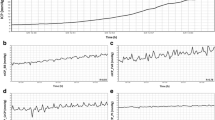Abstract
Background/purpose
Increased slow-wave activity in intracranial pressure (ICP) signifies an exhausted cerebrospinal compensatory reserve across a range of conditions. In this study, we attempted to describe synchronisation between slow waves of ICP and of near-infrared spectroscopy (NIRS) variables during controlled elevation of ICP.
Method
Nineteen patients presenting with symptomatic hydrocephalus underwent a Computerised Infusion Test. NIRS-derived indices, ICP and arterial blood pressure (ABP) were recorded simultaneously.
Findings
ICP increased from 9.3 (6.0) mmHg to a 17.1 (8.9) mmHg during infusion. Slow waves in ICP were accompanied by concurrent waves in each NIRS variable (including deoxygenated haemoglobin (Hb) and oxygenated haemoglobin (HbO2)) with a mean coherence of >0.7 and no significant phase shift. In the same bandwidth (0.3–1.8 min−1), ABP fluctuations occurred with a coherence of 0.77 and phase lead of 40° with respect to ICP. The power of ICP slow waves increased significantly during infusion plateau with a corresponding increase in power of Hb waves.
Conclusions
Slow fluctuations in cerebral oximetry as detected by NIRS coincide with and are implicated in the origin of ICP slow waves and increases during periods of exhausted cerebrospinal compensatory reserve. NIRS may be used as a non-invasive marker of increased ICP slow waves (and therefore reduced CSF compensatory reserve).




Similar content being viewed by others
References
Al-Rawi PG, Smielewski P, Kirkpatrick PJ (2001) Evaluation of a near-infrared spectrometer (NIRO 300) for the detection of intracranial oxygenation changes in the adult head. Stroke 32:2492–2500
Borgesen SE, Albeck MJ, Gjerris F, Czosnyka M, Laniewski P (1992) Computerized infusion test compared to steady pressure constant infusion test in measurement of resistance to CSF outflow. Acta Neurochir 119:12–16
Brady KM, Lee JK, Kibler KK, Smielewski P, Czosnyka M, Easley RB, Koehler RC, Shaffner DH (2007) Continuous time–domain analysis of cerebrovascular autoregulation using near-infrared spectroscopy. Stroke 38(10):2818–2825
Czosnyka M, Whitehouse H, Smielewski P (1996) Testing of cerebrospinal compensatory reserve in shunted and non- shunted patients: a guide to interpretation based on an observational study. J Neurol Neurosurg Psychiatry 60:549–558
Delpy DT, Cope M, van der Zee P, Arridge S, Wray S, Wyatt JS (1988) Estimation of optical pathlength through tissue from direct time of flight measurement. Phys Med Biol 33:1433–1442
Droste DW, Krauss JK (1993) Simultaneous recording of cerebrospinal fluid pressure and middle cerebral artery blood flow velocity in patients with suspected symptomatic normal pressure hydrocephalus. J Neurol Neurosurg Psychiatry 56(1):75–79
Halsey JH, McFarland S (1974) Oxygen cycles and metabolic autoregulation. Stroke 5:219–225
Lemaire JJ, Khalil T, Cervenansky F, Gindre G, Boire JY, Bazin JE, Irthum B, Chazal J (2002) Slow pressure waves in the cranial enclosure. Acta Neurochir (Wien) 144(3):243–254
Lescot T, Naccache L, Bonnet MP, Abdennour L, Coriat P, Puybasset L (2005) The relationship of intracranial pressure Lundberg waves to electroencephalograph fluctuations in patients with severe head trauma. Acta Neurochir (Wien) 147(2):125–129
Lundberg N (1960) Continuous recording and control of ventricular fluid pressure in neurosurgical practice. Acta Psychiatr Neurol Scand Suppl 36:1–193
McCormick PW, Stewart M, Goetting MG, Dujovny M, Lewis G, Ausman JI (1991) Noninvasive cerebral optical spectroscopy for monitoring cerebral oxygen delivery and hemodynamics. Crit Care Med 19(1):89–97
Newell DW, Aaslid R, Stooss R, Reulen HJ (1992) The relationship of blood flow velocity fluctuations to intracranial pressure B waves. J Neurosurg 76(3):415–421
Owen-Reece H, Smith M, Elwell CE, Goldstone JC (1999) Near infrared spectroscopy. Br J Anaesth 82(3):418–426
Razavi M, Eaton B, Paradiso S, Mina M, Hudetz AG, Bolinger L (2008) Source of low-frequency fluctuations in functional MRI signal. J Magn Reson Imaging 27(4):891–897
Reinhard M, Wehrle-Wieland E, Grabiak D, Roth M, Guschlbauer B, Timmer J, Weiller C, Hetzel A (2006) Oscillatory cerebral hemodynamics—the macro- vs. microvascular level. J Neurol Sci 250(1–2):103–109
Steiner LA, Pfister D, Strebel SP, Radolovich D, Smielewski P, Czosnyka M (2009) Near-infrared spectroscopy can monitor dynamic cerebral autoregulation in adults. Neurocrit Care 10(1):122–128
Steinmeier R, Bauhuf C, Hubner U, Bauer RD, Fahlbusch R, Laumer R, Bondar I (1996) Slow rhythmic oscillations of blood pressure, intracranial pressure, microcirculation, and cerebral oxygenation. Stroke 27:2236–2243
Ward KR, Ivatury RR, Barbee RW, Terner J, Pittman R, Filho IP, Spiess B (2006) Near infrared spectroscopy for evaluation of the trauma patient: a technology review. Resuscitation 68(1):27–44
Westmaier T, Jauss A, Eriskat J, Kunze E, Roosen K (2009) Acute vasoconstriction: decrease and recovery of cerebral blood flow after various intensities of experimental subarachnoid hemorrhage in rats. J Neurosurg 110(5):996–1002
Zweifel C, Czosnyka M, Lavinio A, Castellani G, Kim DJ, Carrera E, Pickard JD, Kirkpatrick PJ, Smielewski P (2009) A comparison study of cerebral autoregulation assessed with transcranial Doppler and cortical laser Doppler flowmetry. Neurol Res 32(4):425–428
Acknowledgements
The project was supported by the National Institute of Health Research Biomedical Research centre, Cambridge University Hospital Foundation Trust—Neurosciences Theme.
JDP is supported by the NIHR Senior Investigator Award.
CZ is supported by the Swiss National Science Foundation (PBBSP3-125550), Bern, Switzerland.
NK is supported by the Joint Royal College of Surgeons/Dunhill Medical Trust Fellowship and the Tunku Abdul Rahman Project Grant
Conflicts of interest and disclosures
ICM + software (www.neurosurg.cam.ac.uk/icmplus) is licenced by the University of Cambridge, Cambridge Enterprise Ltd. PS and MC have a financial interest in a part of the licencing fee.
CZ received a travel grant from Hamamatsu Photonics, Welwyn Garden City, Hertfordshire, UK.
Author information
Authors and Affiliations
Corresponding author
Additional information
Comments
The present study shows both correlation and coherence between ICP slow/B waves and NIRS derived slow waves in controlled increase of ICP. Although the results are robust the significance of B waves is still under discussion and thus the practical implications pending.
Peter Siesjo
Lund, Sweden
Rights and permissions
About this article
Cite this article
Weerakkody, R.A., Czosnyka, M., Zweifel, C. et al. Slow vasogenic fluctuations of intracranial pressure and cerebral near infrared spectroscopy—an observational study. Acta Neurochir 152, 1763–1769 (2010). https://doi.org/10.1007/s00701-010-0748-9
Received:
Accepted:
Published:
Issue Date:
DOI: https://doi.org/10.1007/s00701-010-0748-9




